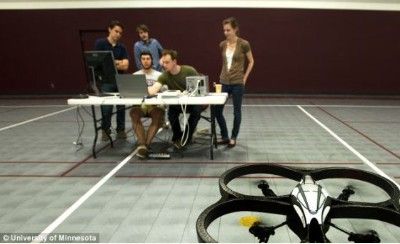
He Bin, a professor at the University of Minnesota in the United States, led a team that developed a quadrotor helicopter that could be controlled with ideas. He Bin said that this is the first time humans can control the flight of a flying robot through their own mind. In the experiment, 5 participants successfully controlled the helicopter flight. The average linear velocity of this quadrotor helicopter is 0.69 meters per second

Participants sat in front of the screen showing the helicopter flight. Their brain signals are recorded using electroencephalography and transmitted to the helicopter via WiFi
According to news from June 13, Beijing time, according to foreign media reports, American scientists have for the first time developed remotely controlled helicopters that can be controlled with ideas. The development of this type of helicopter is only the first step. They hope to develop robots that will enable paralyzed and neurodegenerative patients to regain their independent living ability in the future. Bin He, a professor at the University of Minnesota, said this is the first time humans can control the flight of a flying robot through their own mind.
The helicopter developed by scientists in Minnesota is a quadrotor helicopter. In the experiment, 5 participants successfully controlled the helicopter flight. The average linear velocity of this quadrotor helicopter is 0.69 meters per second. The researchers used the screen to display the images taken by the onboard camera of the quadrotor helicopter. The participants were arranged in front of this screen, allowing them to clearly see the helicopter's flight direction. Their brain signals are recorded using electroencephalography and transmitted to the helicopter via WiFi.
The researchers asked participants to imagine using their right hand, left hand, or both. These ideas were converted into commands, which ordered the helicopter to turn right, turn left, take off, and land. Subsequently, they asked the participants to control the helicopter through two foam rings suspended under the ceiling of the gymnasium, observe their performance, and then score their performance by analyzing statistical data.
In a control experiment, participants used a keyboard to control the helicopter. Through these two different experiments, scientists were able to compare standard control methods and idea control. He Bin said: "In the previous research, we have confirmed that humans can control a virtual helicopter through their minds. I initially decided to use a small helicopter for this kind of research, but I finally chose a quadrotor helicopter because This type of helicopter is more stable and safer. "
Currently, scientists in Minnesota are using this technology to find ways to help restore hearing, vision, and athletic ability. Visually speaking, it is to build a bridge between the brain and external devices. He Bin said: "Our next goal is to use non-invasive brainwave signals to control the robotic arm. To achieve this goal, we need to develop a brain-computer interface. This interface will benefit patients with paralysis or neurodegenerative diseases."
BNF HARDWARE CO., LTD , https://www.bnfhandles.com